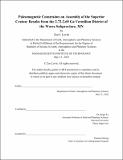Paleomagnetic Constraints on Assembly of the Superior Craton: Results from the 2.72-2.69 Ga Vermilion District of the Wawa Subprovince, MN
Author(s)
Levitt, Zoe I.
DownloadThesis PDF (2.358Mb)
Advisor
Fu, Roger
Terms of use
Metadata
Show full item recordAbstract
Paleomagnetism can reveal ancient tectonic motions and identify the processes that regionally overprint magnetizations. We present paleomagnetic data from greenstones in the 2.72-2.69 Ga Vermillion Belt, Superior Craton, Minnesota. The Vermillion Belt has experienced lower greenschist facies alteration associated with volcanic-hosted massive sulfide (VHMS) deposits on the Archean paleoseafloor, as well as weak metamorphism from later reworking events.
We isolate four magnetization components: a low-temperature viscous remanent magnetization (VRM) recording the present geomagnetic field, a mid-temperature direction consistent with a ~1.11 Ga Midcontinent Rift overprint, a higher temperature component interpreted to be a 1.78 Ga Penokean overprint, and a high-temperature component that exhibits two clusters in in situ coordinates depending on locality: samples from the southern limb of an anticline host a direction D, I = 165.82°, -70.23° (α₉₅ = 14.4°; n= 2 VGPs), while those from the northern limb host D, I = 198.5°, 78.85° (α₉₅ = 14.0°; n = 5 VGPs). To understand the relative timing of these magnetization directions, we also report results for a 2.69 Ga fold test and baked contact test, a 1.78-1.11 Ga baked contact test, and a conglomerate test.
Based on these field tests, we constrain our high temperature component magnetization to either a VMS-related primary thermochemical remanent magnetization at 2.69 Ga, or a 1.78 Ga thermochemical post-orogenic overprint associated with the collapse of the Penokean Orogeny. If primary, our data define a paleopole at 46.85°N/ 84.12°E (α₉₅ = 14.95°; n = 7 VGPs). This would suggest rapid plate motion during the accretion of the Wawa-Abitibi Terrane onto the Superior Craton, suggesting that subduction leading to ribbon continent accretion occurred at a higher velocity than observed in Phanerozoic time. However, more data is required before this motion can be fully confirmed.
Date issued
2022-05Department
Massachusetts Institute of Technology. Department of Earth, Atmospheric, and Planetary SciencesPublisher
Massachusetts Institute of Technology